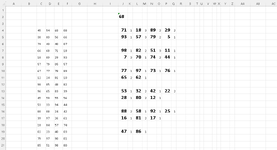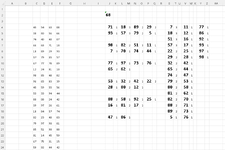Hello all,
Dante and Peter helped me with my original request, which is posted here: Number Search / return corresponding number strings
Sample 1 picture is how the returned numbers look. I need it modified a little so that the returned numbers are also put order from the highest hits to least returned hits. See Sample 2 picture.
The results of the returned numbers are put in columns J, L, N and P along with how many hits each of those numbers have next to them in columns K, M, O and Q. The way the returned numbers are makes difficult
to sort. Having the results in order by hit quantity (Sample 2 picture) would make sorting easier.
what I would like is to have the returned numbers also arranged in order of the number of hits found in columns K, M, O and Q of each of the actual numbers found in Columns J, L, N and P. If there are several numbers with the same hit quantity, then put returned numbers in numerical order smallest to bigger... for example, the numbers 7, 18, 51 and 57 all had 3 hits each... so those 4 numbers can be in numerical order. Next are the returned numbers with 2 hits each, so put those number is numerical order smallest 22 to biggest 89. Next comes the returned numbers with 1 hit each, 5 to 98.
Thank you,
Dave
Dante and Peter helped me with my original request, which is posted here: Number Search / return corresponding number strings
Sample 1 picture is how the returned numbers look. I need it modified a little so that the returned numbers are also put order from the highest hits to least returned hits. See Sample 2 picture.
The results of the returned numbers are put in columns J, L, N and P along with how many hits each of those numbers have next to them in columns K, M, O and Q. The way the returned numbers are makes difficult
to sort. Having the results in order by hit quantity (Sample 2 picture) would make sorting easier.
what I would like is to have the returned numbers also arranged in order of the number of hits found in columns K, M, O and Q of each of the actual numbers found in Columns J, L, N and P. If there are several numbers with the same hit quantity, then put returned numbers in numerical order smallest to bigger... for example, the numbers 7, 18, 51 and 57 all had 3 hits each... so those 4 numbers can be in numerical order. Next are the returned numbers with 2 hits each, so put those number is numerical order smallest 22 to biggest 89. Next comes the returned numbers with 1 hit each, 5 to 98.
VBA Code:
Sub Number_Search()
Dim dic As Object
Dim a As Variant, b As Variant
Dim i&, j&, n&, jj&, ii&, y&, k&, m&, nRow&, nCol&
Dim num As String, myNum As String
Dim f As Range
Set dic = CreateObject("Scripting.Dictionary")
num = Range("J2").Text
If num = "" Then
MsgBox "Enter value in J2"
Exit Sub
End If
Set f = Range("C:F").Find(num, , xlValues, xlWhole)
If f Is Nothing Then
MsgBox "Number does not exists"
Exit Sub
End If
a = Range("C4:F" & Range("C" & Rows.Count).End(3).Row + 4).Value
n = WorksheetFunction.CountIf(Range("C:F"), num)
ReDim b(1 To n * 4, 1 To 8)
y = -1
Range("J4:Q" & Rows.Count).ClearContents
For i = 1 To UBound(a, 1)
For j = 1 To UBound(a, 2)
myNum = "" & a(i, j)
If myNum = num Then
y = y + 2
m = j + 1
k = -1
For ii = i To i + 2
For jj = m To UBound(a, 2)
myNum = "" & a(ii, jj)
If myNum <> "" Then
If Not dic.exists(myNum) Then
k = k + 2
If k = 9 Then
k = 1
y = y + 1
End If
dic(myNum) = y & "|" & k
End If
nRow = Split(dic(myNum), "|")(0)
nCol = Split(dic(myNum), "|")(1)
b(nRow, nCol) = myNum
b(nRow, nCol + 1) = b(nRow, nCol + 1) + 1
End If
Next jj
m = 1
Next ii
End If
Next j
Next i
Range("J4").Resize(UBound(b, 1), UBound(b, 2)).Value = b
End SubThank you,
Dave







